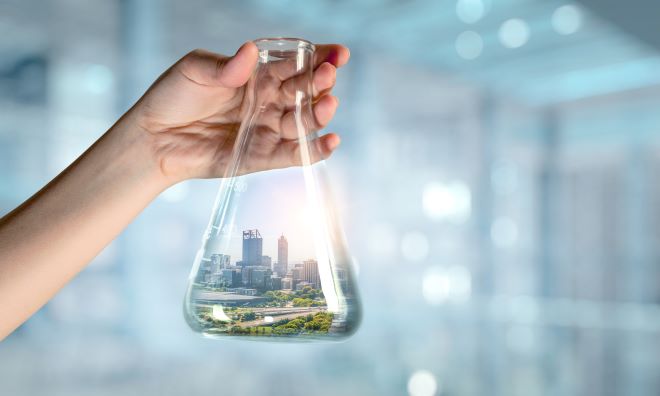Angie Ziech-Malek, Zondits guest, 10/21/2022
With the recent enactment of the Inflation Reduction Act, and the Infrastructure Law that preceded it, the United States is about to embark on a large experiment with energy policy, funded by the federal government, and each state’s energy policy experiment will determine how these investments pay off.
States are sometimes referred to as the “laboratories of democracy” because of their ability to test social policies in a manner similar to the scientific method. If one state hypothesizes that a certain policy may help, for example, alleviate child poverty, the state has the freedom to enact such a policy and measure the results. In theory, what works gets exported and replicated in other states… although political polarization has somewhat thrown a wrench in this ideal.
For many recent years, climate policy in the United States has been inconsistent on the federal level with many state and local governments taking initiative. Some states have shown tremendous clean energy leadership in recent history. Hawaii was the first state to legislate their clean energy commitment with the 100% Renewable Portfolio Standard law that passed in 2015. In 2018, the state passed legislation to decarbonize Hawaii’s entire economy. California followed in 2018 with legislation that set a goal of statewide carbon neutrality by 2045. A flurry of similar legislation has passed in other states in the past few years. Illinois, Maine, Maryland, Massachusetts, New Mexico, Rhode Island, Washington, and others have passed landmark energy legislation at the state level.
What these laws have in common are commitments to transform their state’s electricity generation. Most states have set goals to decarbonize their energy supply by 2050, with some states aiming for 2040 or 2045. Rhode Island is especially aggressive with their commitment to 100% renewable energy electricity by 2030. Having learned lessons from previous economic transitions (e.g., automation in the manufacturing sector), states are experimenting with how to support communities in their clean energy transition. Several of these state laws (such as Maryland and New Mexico) include workforce development provisions to help train a local workforce to build out these clean energy projects. Many also contain equity and environmental justice provisions as well as assistance for areas impacted by the closure of fossil fuel generation sites.
But, just as states have different political preferences and socio-economic structures, states are taking a variety of approaches to clean energy policy. States without statutory clean energy mandates like Louisiana, Michigan, and Wisconsin have adopted ambitious climate action plans through Executive Orders. Colorado and Minnesota are addressing gas utility decarbonization with clean heat standards and pathways for dual-fuel utilities to explore opportunities to shift from fossil fuels to zero-carbon energy sources. Iowa and Texas have developed robust wind energy supplies without explicit statutory clean energy requirements. How will the deployment of clean energy projects compare in these states? What will be the main drivers for clean energy projects, specific types of public policy support, competitive energy markets, or natural conditions (high potential for wind and solar) or some combination thereof?
With the federal government’s passage of the Infrastructure Investment and Jobs Act (IIJA) and the Inflation Reduction Act (IRA) the landscape for clean energy policy is changing. If states are the laboratories of clean energy policy, the IIJA and IRA are the catalysts that will accelerate state clean energy policy commitments into real clean energy projects. According to an economic analysis by the Advanced Energy Economy (AEE), an industry group, the combined federal commitment to advanced energy in the IIJA and the IRA amounts to $444 billion, which they further forecast will spur $2.8 trillion in total incremental economic activity (GDP). This funding will flow down to the states for implementation according to each state’s particular set of policies and rules. While the Department of Energy will issue guidance on how to spend the IIJA and IRA funds, it will be up to state energy offices to determine the exact rules such as eligibility requirements that determine where these funds go in their state.
How those benefits flow down by geographies will depend on the clean energy policy environment that each state has cultivated and the set of rules each state promulgates for the federal funds. AEE assumes benefits will accrue according to population, but also states that: “State-specific factors – such as clean energy standards, permitting regimes, and the presence of energy industry and manufacturing communities – are likely to also serve as magnets for federal and private sector investment enabled by the IRA and IIJA, potentially driving a disproportionate share of benefits to those states.”1 Many significant state Governor races are being contested this November and energy policy is clearly on the ballot. States will continue to experiment with clean energy policy depending on the outcomes of these elections. Some states will lead, and others will follow. Of the total IRA and IIJA funds that will be available to states for clean energy projects, some may flow automatically to established state programs, while other funds may be available on a competitive basis. As the AEE suggests, aggressive states may seek and receive proportionally more of the available federal dollars and may experience proportionally more economic benefits as a result. Regardless, new policy experiments are sure to be developed with the assistance of these federal investments.
1 Advanced Energy Economy, Economic Impact of Advanced Energy Investment From the Infrastructure Investment and Jobs Act and Inflation Reduction Act
Clean Energy States Alliance, 100% Clean Energy Collaborative Project

